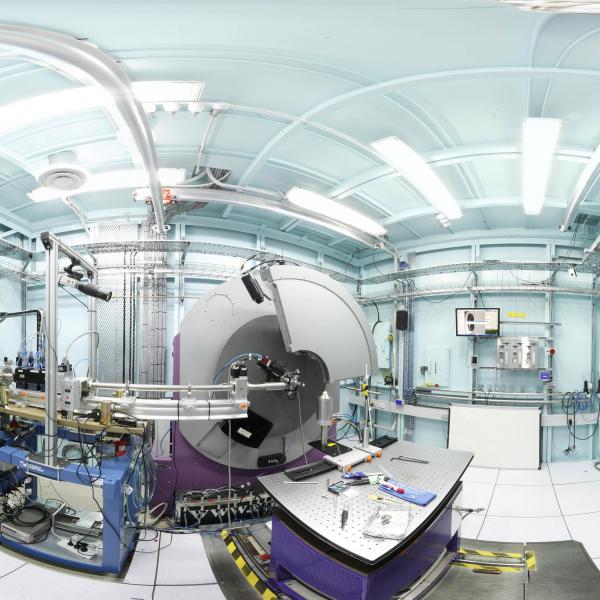

Published on the 6th August 2020 by ANSTO Staff
Key Points
-
Explaining scientific data acquired by NASA expeditions is an important part of planetary studies
-
Research reports for the first time how solid methane and nitrogen expand in response to temperature changes with relevance for understanding glaciers on Pluto
-
Measurements on the high-intensity powder diffractometer Wombat simulated temperature conditions on Pluto
Planetary scientist Dr Helen Maynard-Casely and associates have reported for the first time how solid methane and nitrogen expand in response to temperature changes and resolved an historic ambiguity relating to the structure of nitrogen.
`The study was inspired by the New Horizons mission, which on its flyby of Pluto five years ago, discovered glaciers of solid methane and nitrogen on the dwarf planet’s surface.
In research published in the IUCrJ journal, they also provided evidence of unexpected changes in the orientation of the grains of the solid methane and nitrogen upon warming, which indicated the grains might be growing.
Pluto, which is tilted to 120 degrees on its axis, experiences seasonal temperature variations from between 24 to 54 Kelvin (-250 to -220 Celsius ) on its 248 year journey around the sun.
“The fact that methane and nitrogen molecules can flow at such extremely low temperatures has to do with how the methane and nitrogen molecules are arranged in their crystal structures, which is why crystallography might be able to answer questions about these unusual landscapes,” said Maynard-Casely.
“In the warmer seasons of Pluto, still about -220 C, both the methane and nitrogen molecules are freely rotating in the solids – the molecules are not bound together very well,” she said.
“Studies of the mechanical properties of these materials at very low temperatures are really challenging, so were are missing useful information for the unusual conditions on the outer planetary bodies.”
Maynard-Casely, who studies the surfaces of the outer icy planets and their moons, recreates those conditions using the Wombat high intensity diffractometer and cryogenic furnaces. She undertook the thermal expansion study of methane and nitrogen as it had not been done previously.
Changes in the density of both molecules are thought to be useful in explaining the glaciology of Pluto.
What was expected to be a straightforward crystallography study of the thermal expansion at a range of temperatures had some unexpected outcomes.

The asymmetric (left) and symmetric (right) crystal structure of nitrogen at temperatures found on Pluto. Wombat data resolved the structure to be symmetric.
“Nitrogen actually has two crystal structures in the range of temperatures seen on Pluto, and I was surprised that the most accepted model for the lower temperature alpha form didn’t fit our data. It turned out that this is a topic that has never been resolved since the 1970s, although the most cited model of the unit cell is the cubic four molecule asymmetric P213 space group,” said Maynard-Casely.
Data was collected on Wombat on a further sample, then five different possible structures were tested again this.
“The data fit the Pa3̅ space group, in which the centre of the molecule lies at the origin of the crystal structure. This is important because the space group affects the physical properties.”
In the alternate model the nitrogen atoms are offset from the origin.
“A structure in the P213 spacegroup could be pyroelectric, which means there could be a release of energy when you heat it up. This would be relevant for glaciology but the Wombat data suggests that this is not the case,” said Maynard-Casely.
“The nitrogen story is really interesting because the molecules have the ability to cool into an ordered structure, which is the alpha nitrogen phase and at this point there is a big volume drop,” explained Maynard-Casely.
“Whereas at a slightly higher temperature, around 44 Kelvin, the nitrogen molecules are freely rotating in a plastic state.”
Phase I of the methane is also described as a plastic phase, in which the weakly interacting nature of the molecules and orientational freedom were thought to impart a mechanical softness.
The research was motivated by the striking images of the surface of Pluto captured by the New Horizons mission five years ago, which depicted towering icy mountains surrounded by lower terrain with apparent flowing features.
“Gone is the thought that Pluto is a dead world. New Horizons has picked up evidence that the dwarf planet has been geologically active throughout its 4 billion year life.”
“It was also interesting to see how little the hydrogen-bonded structure, water, expanded over the same temperature range,” said Maynard-Casely.
“You see water as an almost straight line in the data plot, whereas methane and nitrogen have significant expansion upon increasing temperatures,” she said.
Instrument scientists Dr Helen Brand and Dr James Hester made contributions to the research.
Further work on the phase transitions of these molecules is planned.



